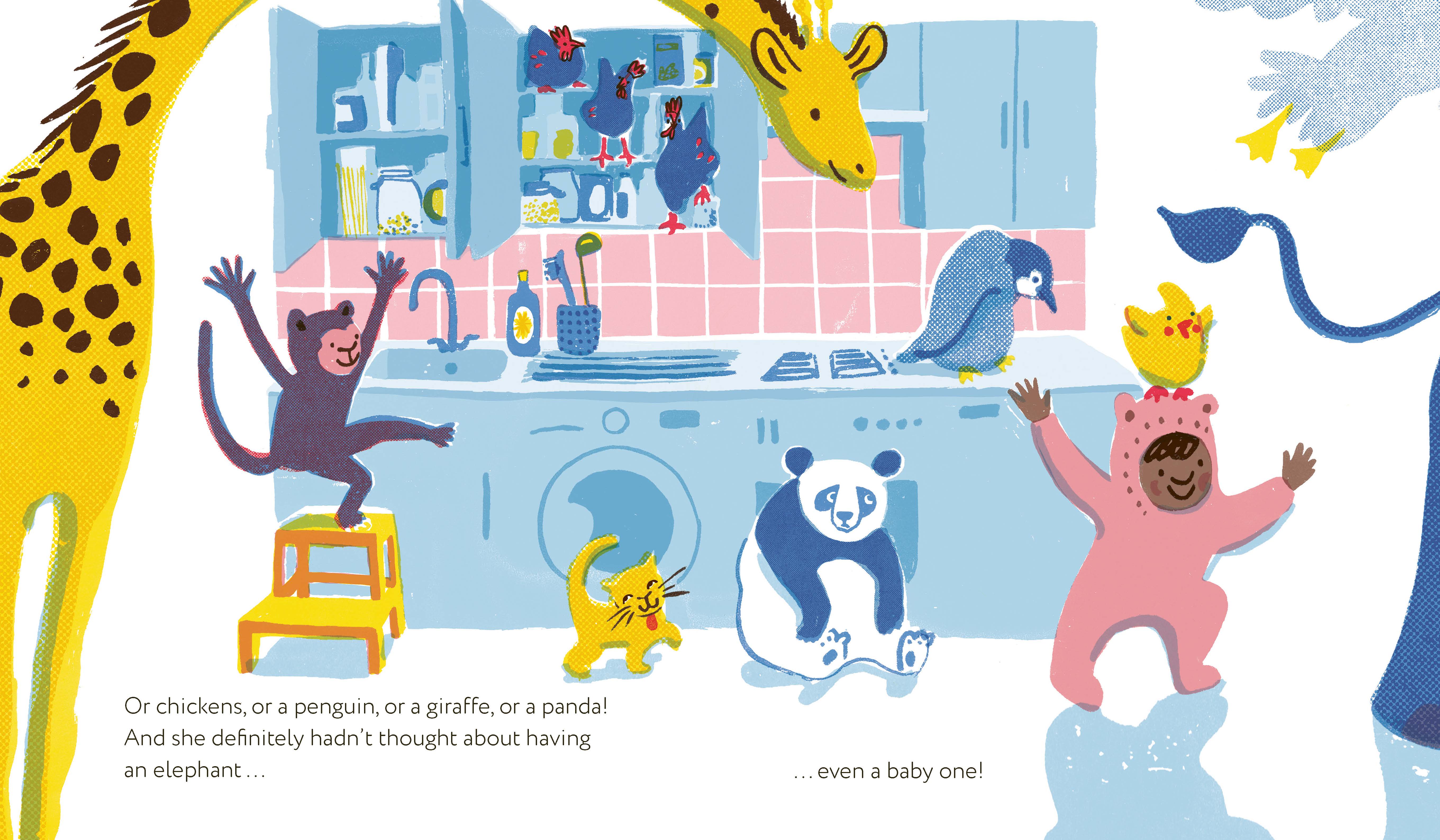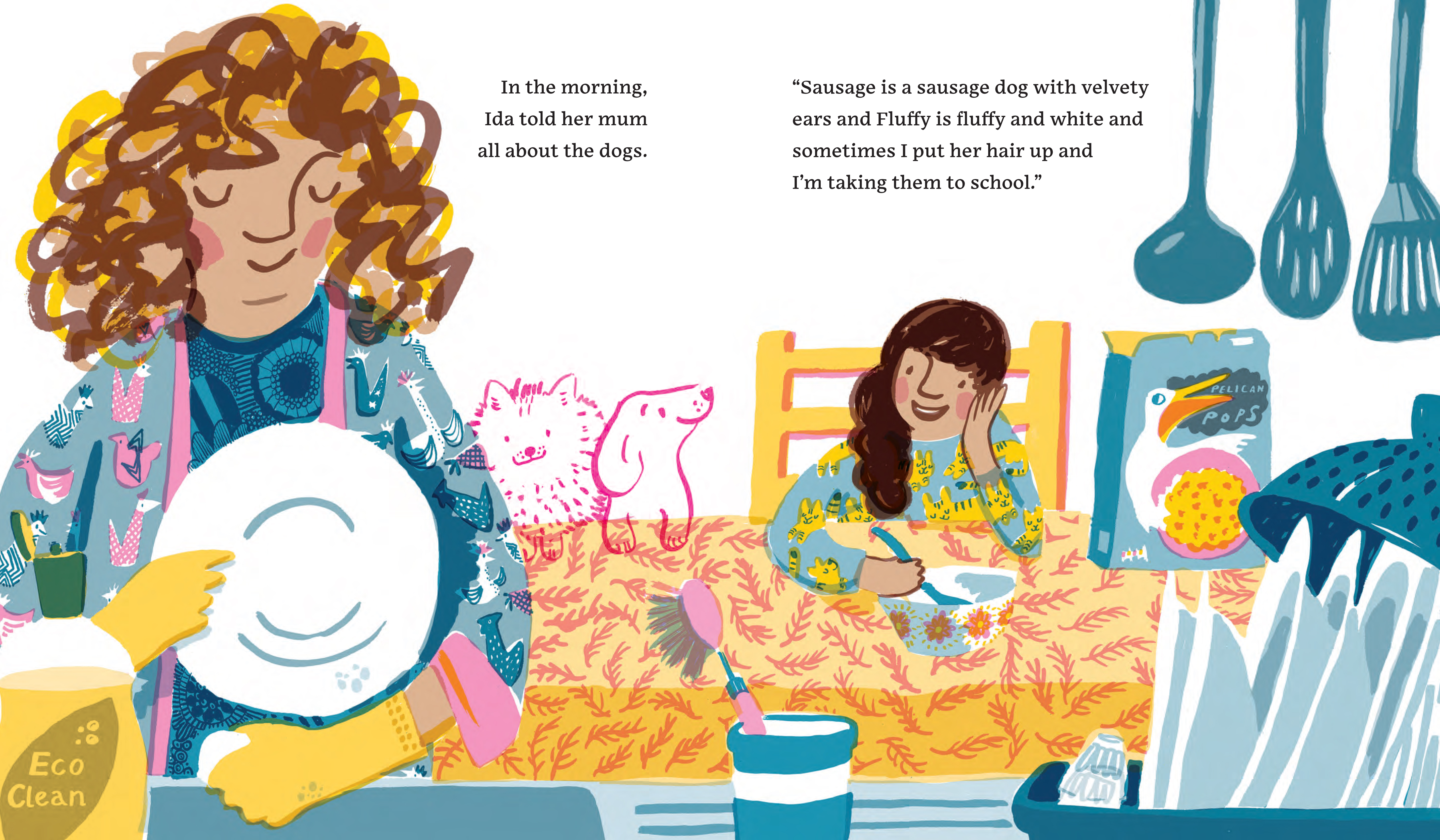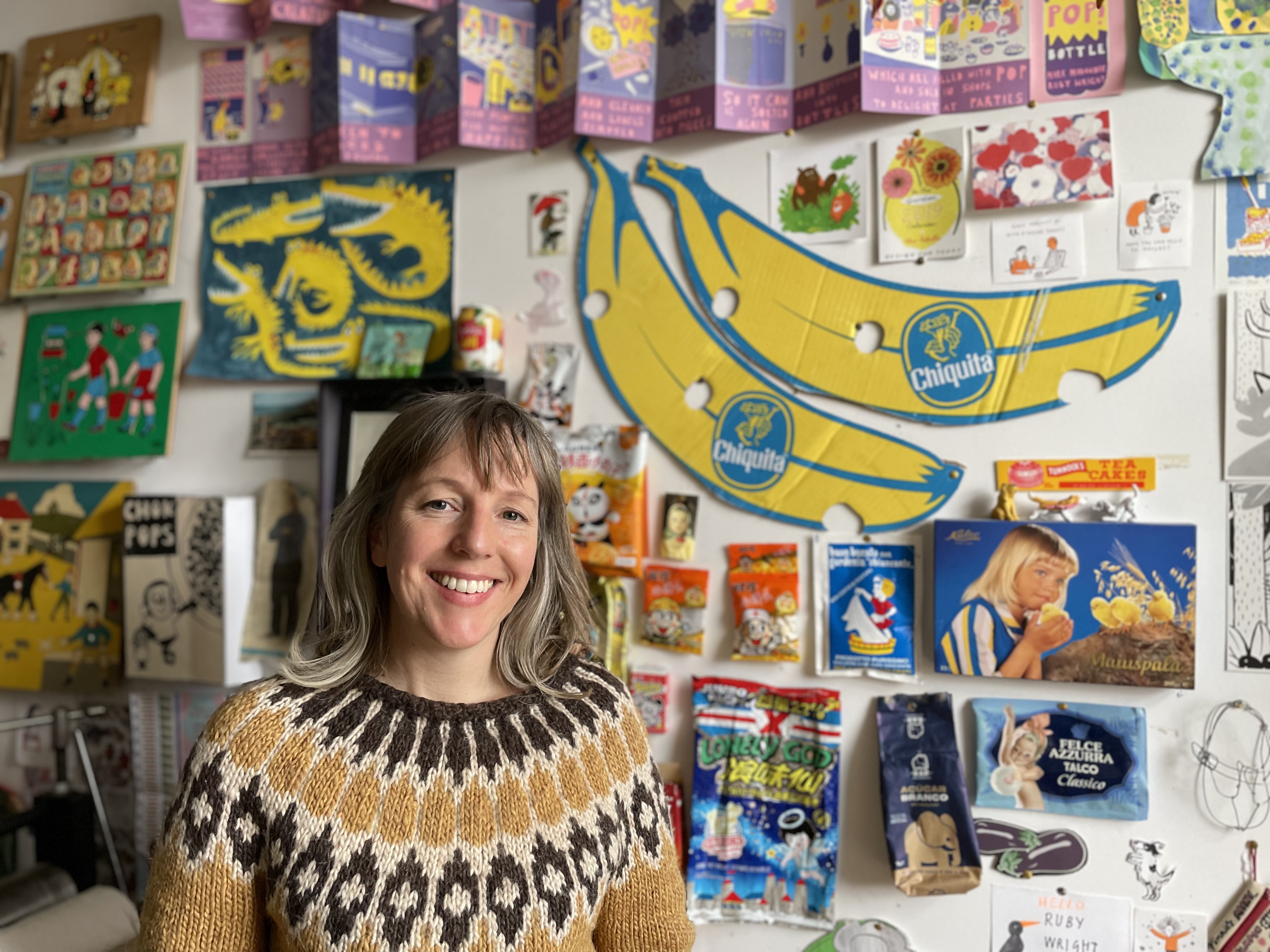 Ruby Wright is a highly respected printmaker, whose masterful command of colour and storytelling is perfectly suited to the creation of picture books. Her debut, Animal Crackers, is a gorgeous story about a little girl who dreams of having her own pet. They may not be allowed to have pets in their flat but Maisie and her mum bring their kitchen to life with an exotic collection of imaginary pets, with a monkey, crocodile, a penguin and a baby elephant portrayed in stunning bright screen print illustrations. (Imaginary) Pets also feature in her second book, Invisible Dogs, a warm-hearted story about make-believe and finding your place in school. Here Ruby captures the school environment perfectly with colourful prints whilst the children's imaginary pets are brought to life in neon pink pantone ink.
Ruby Wright is a highly respected printmaker, whose masterful command of colour and storytelling is perfectly suited to the creation of picture books. Her debut, Animal Crackers, is a gorgeous story about a little girl who dreams of having her own pet. They may not be allowed to have pets in their flat but Maisie and her mum bring their kitchen to life with an exotic collection of imaginary pets, with a monkey, crocodile, a penguin and a baby elephant portrayed in stunning bright screen print illustrations. (Imaginary) Pets also feature in her second book, Invisible Dogs, a warm-hearted story about make-believe and finding your place in school. Here Ruby captures the school environment perfectly with colourful prints whilst the children's imaginary pets are brought to life in neon pink pantone ink.
From her early picture book collection to tv classics, Ruby shares the art and culture that has influenced her work.
I grew up in a farmhouse up a track in Dorset. My Dad is a photographer and my Mum is a sculptor. Our house was full of strange and beautiful things that had been made or collected or photographed.
 © George Wright
© George Wright
We didn’t have a telly until I was 8 but I listened to stories on cassette tapes narrated by actors like Brian Blessed and Joanna Lumley who conjured up magical worlds and I had lots of picture books. My favourites were by Janet and Allen Ahlberg and Maurice Sendak and Bob Graham and Susanna Gretz and Helen Oxenbury and Babette Cole and Raymond Briggs. They were my earliest visual influences, this was my own collection of masterpieces.

 I kept these books with me from then until now, moving them from house to bed-sit to flat and to another flat, dipping into them periodically through my life, transported Proust-like, back to that dreamy surreal time of childhood, which felt so vivid and full of possibility and wonder and potential danger. The stuff that happens when we’re little has such an impact, it resonates through our entire lives, forms us. I really feel like those books are part of my fabric. That scene in The Sign on Rosie’s Door where all the children come in at dusk from playing in the street and hug their mothers, I’ve almost incorporated it as my own memory.
I kept these books with me from then until now, moving them from house to bed-sit to flat and to another flat, dipping into them periodically through my life, transported Proust-like, back to that dreamy surreal time of childhood, which felt so vivid and full of possibility and wonder and potential danger. The stuff that happens when we’re little has such an impact, it resonates through our entire lives, forms us. I really feel like those books are part of my fabric. That scene in The Sign on Rosie’s Door where all the children come in at dusk from playing in the street and hug their mothers, I’ve almost incorporated it as my own memory.
And then when I was eight my parents took me to see Hairspray by John Waters at the Yeovil Odeon.

And I fell in love with Ricky Lake’s Tracy Turnblad and her mother played by Divine, and I fell in love with the music and the storytelling and Waters’ cinematography and the silliness of it all but with an underlying solid rhythm of the quest for justice.
And then we got a telly and I was allowed to watch Dennis Potter’s Singing Detective.

Which was surreal and dark and beautiful and haunting and again had really great music. And I also inhaled soap operas and comedies and adverts, those perfect 30 seconds of storytelling.
And when my parents separated I self medicated with so much Victoria Wood’s As Seen on TV that I can still recite much of it verbatim.

In all these examples I love the combination of beauty and pathos and silliness, of high art and low culture. I feel that these artists and filmmakers capture something profound about the human condition.

And so it was that I attempted to capture something of the human condition, in particular the concerns of a child in my new book, Invisible Dogs. The story came about when my daughter, desperate for a pet and lacking a companion at school, invented two invisible dogs. When I asked her about them, the world she had created was so real to her that she was able to describe in detail the dogs and their routines and desires. She took them to school and started playing invisible dogs with another little girl, and through this game the two of them became great friends.

It was a gift of a story and it didn’t require a great deal of embellishment. My editor, Libby Hamilton, injected the story with meaning which is one of her superpowers, but all her suggestions felt right to me because the difficult emotions the main character is dealing with are universal. Although it’s not explicit in the story, the main character is grappling with the separation of her parents, something so many kids including me experience. And all of us have at some point felt friendless or lonely or that we don’t fit in. So all those things are in the story but I also wanted it to just feel normal and bearable and to include a lot of silliness and fun.

When I was making the thumbnails for Invisible Dogs I watched a lot of films which I think shows in the composition of the images. Invisible Dogs is set in my home and around my neighbourhood, and as I sketch from life all the time, I was able to use a lot of my drawings as a starting point for this book. I also included things that I adore and sketch over and over again: advertising billboards, pollarded trees, chimney pots, patterns and people.

Animal Crackers and Invisible Dogs, written and illustrated by Ruby Wright, are published by Rocket Bird Books, and are available to buy now. We have a full review for each title and you can also download a few more pages of stunning print illustrations.
A penguin? a monkey? a unicorn? what imaginary pet would you pick?






Comments (23)
Penny H - 9th July 2024
I would have a unicorn which could magic me away to a colourful, rainbowy land whenever I wanted to escape.Caroline S - 8th July 2024
An imaginary puffin would be delightful!Emma W - 8th July 2024
I would love an imaginary penguin as it is our favourite bird however they are quite messy hence it would be good to be imaginary lolMargaret G - 7th July 2024
Would be a monkey - we both love monkey tricks and funVictoria P - 7th July 2024
I also had an imaginary dog when I was young - I also had a mouse! I even bought a cage from a charity shop where he lived.... These days I'd have a monkey!Pauline A - 6th July 2024
I would love a house-trained hen who could live indoors like a catGill W - 6th July 2024
I would have a Badger as a pet as it would save it from human persecution.S P - 6th July 2024
I think everyone should have an invisible pet- mine would be a giraffe (not that I’ve ever thought about this?Sue O - 5th July 2024
It would have to be a catLinda R - 5th July 2024
A lovely cool polar bearLaura T - 3rd July 2024
An invisible dog, they are the best companions!Jed H - 2nd July 2024
It would have to be a capybaraAngela M - 30th June 2024
I'd love an imaginary panda!Maya R - 30th June 2024
I would fly on a eagle-winged zebra.Susan B - 27th June 2024
How lovely! I didn't have an invisible pet when I was young but I would choose a Turtle Dove. They are such beautiful, courageous and gentle little souls.Michelle S - 27th June 2024
I would have a monkey because they are so playful.David W - 26th June 2024
A flying dog with Large ears and a kind heart.Catherine S - 25th June 2024
I'd have a dog as an imaginary pet.helen w - 25th June 2024
I would have an imaginary dragon to fly me where I need to beMARIA R - 25th June 2024
I would still love an imaginary dog and think about it oftenPriscilla S - 25th June 2024
I would love a pet penguinSally C - 25th June 2024
I think I would have an imaginary wolf, strong but gentle as well and he would, of course, be able to talk.Pamela T - 25th June 2024
My early pictures in books love was Rupert Bear and I will have an invisible bear friend.Leave A Reply
You must be logged in to post a comment.